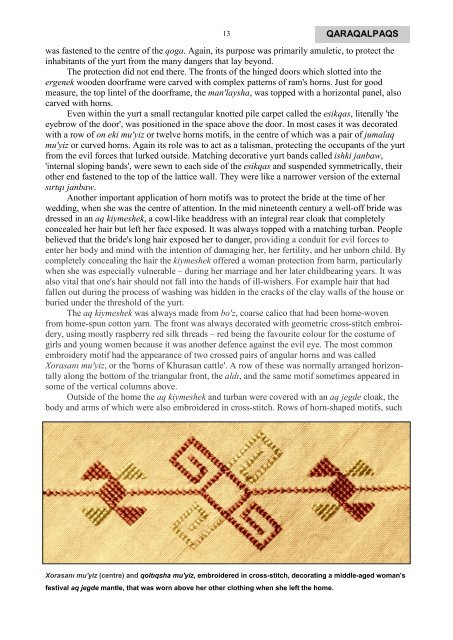ASIAN TEXTILES - OATG. Oxford Asian Textile Group
ASIAN TEXTILES - OATG. Oxford Asian Textile Group
ASIAN TEXTILES - OATG. Oxford Asian Textile Group
Create successful ePaper yourself
Turn your PDF publications into a flip-book with our unique Google optimized e-Paper software.
13 QARAQALPAQSwas fastened to the centre of the qoga. Again, its purpose was primarily amuletic, to protect theinhabitants of the yurt from the many dangers that lay beyond.The protection did not end there. The fronts of the hinged doors which slotted into theergenek wooden doorframe were carved with complex patterns of ram's horns. Just for goodmeasure, the top lintel of the doorframe, the man'laysha, was topped with a horizontal panel, alsocarved with horns.Even within the yurt a small rectangular knotted pile carpet called the esikqas, literally 'theeyebrow of the door', was positioned in the space above the door. In most cases it was decoratedwith a row of on eki mu'yiz or twelve horns motifs, in the centre of which was a pair of jumalaqmu'yiz or curved horns. Again its role was to act as a talisman, protecting the occupants of the yurtfrom the evil forces that lurked outside. Matching decorative yurt bands called ishki janbaw,'internal sloping bands', were sewn to each side of the esikqas and suspended symmetrically, theirother end fastened to the top of the lattice wall. They were like a narrower version of the externalsırtqı janbaw.Another important application of horn motifs was to protect the bride at the time of herwedding, when she was the centre of attention. In the mid nineteenth century a well-off bride wasdressed in an aq kiymeshek, a cowl-like headdress with an integral rear cloak that completelyconcealed her hair but left her face exposed. It was always topped with a matching turban. Peoplebelieved that the bride's long hair exposed her to danger, providing a conduit for evil forces toenter her body and mind with the intention of damaging her, her fertility, and her unborn child. Bycompletely concealing the hair the kiymeshek offered a woman protection from harm, particularlywhen she was especially vulnerable – during her marriage and her later childbearing years. It wasalso vital that one's hair should not fall into the hands of ill-wishers. For example hair that hadfallen out during the process of washing was hidden in the cracks of the clay walls of the house orburied under the threshold of the yurt.The aq kiymeshek was always made from bo'z, coarse calico that had been home-wovenfrom home-spun cotton yarn. The front was always decorated with geometric cross-stitch embroidery,using mostly raspberry red silk threads – red being the favourite colour for the costume ofgirls and young women because it was another defence against the evil eye. The most commonembroidery motif had the appearance of two crossed pairs of angular horns and was calledXorasanı mu'yiz, or the 'horns of Khurasan cattle'. A row of these was normally arranged horizontallyalong the bottom of the triangular front, the aldı, and the same motif sometimes appeared insome of the vertical columns above.Outside of the home the aq kiymeshek and turban were covered with an aq jegde cloak, thebody and arms of which were also embroidered in cross-stitch. Rows of horn-shaped motifs, suchXorasanı mu'yiz (centre) and qoltıqsha mu'yiz, embroidered in cross-stitch, decorating a middle-aged woman'sfestival aq jegde mantle, that was worn above her other clothing when she left the home.
















